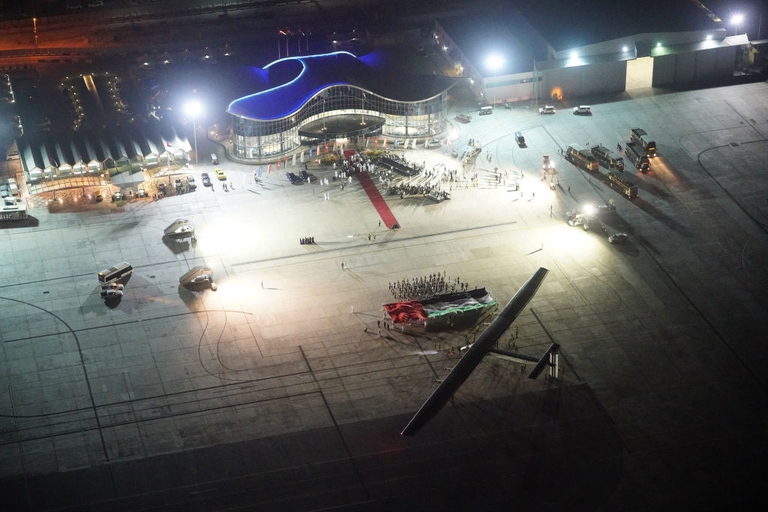
A group of experts in Tokyo suggested pouring radioactive water from Fukushima into the open sea. A marine biochemist explains the consequences of this absurd decision.
For the first time ever a plane powered by solar energy has completed a round-the-world trip, flying 40,000 km without fuel. Watch the video of its last, triumphal landing.
They finally did it. Bertrand Piccard and André Borschberg have made their dream come true going on a journey around the world with a solar-powered aircraft. Two pioneers who have made history. After landing in Abu Dhabi at 12.05 UTC Solar Impulse 2 concluded its flight of 43,000 kilometres, which was accomplished in 23 days and 17 stages. It travelled across the Pacific and Atlantic, the United States, part of Europe and the Middle East. It flew even during the night, using the solar energy collected by the solar panels that charged its batteries.
The solar aircraft took off in March 2015 and was piloted by two Swiss pioneers, demonstrating the potential of its technology for the sustainable mobility of the future.
“I hope people will understand that it is not just a first in the history of aviation, but also a first in the history of energy. I’m sure that, within 10 years, we’ll see electric airplanes transporting 50 passengers on short- to medium-haul flights. But it’s not enough”, the founder of Solar Impulse Bertrand Piccard said from the cockpit. “The same clean technologies used on Solar Impulse could be implemented on the ground in our daily life to divide by two the CO2 emissions in a profitable way. Solar Impulse is just the beginning”.
This adventure of the XXI century made it possible to set many records. These include an uninterrupted solo journey of 8,924 kilometres, five days and five nights (117 hours and 52 minutes 8 hours). Flying with a brand new airplane is hard, but making a round-the-world trip with it is a real challenge. “More than a demonstration, it’s the confirmation that these technologies are truly dependable and reliable”, André Borschberg highlighted. “There is so much potential for the aeronautical world: while 100-percent-solar-powered airplanes might take longer to materialize, electric airplanes will develop in the near future because of their tremendous advantages, such as energy efficiency”.
UN Secretary-General Ban Ki-Moon commented enthusiastically: “Solar Impulse has flown more than 40,000 kilometers without fuel, but with an inexhaustible supply of energy and inspiration. This is a historic day for Captain Piccard and the Solar Impulse team, but it is also a historic day for humanity”.
From Icarus to the Wright brothers. From the Italian aircraft manufacturers Caproni to Russian Muromets. Today it’s Piccard’s and Bertrand’s turn, two pioneers who have changed forever the history of aviation.
Siamo anche su WhatsApp. Segui il canale ufficiale LifeGate per restare aggiornata, aggiornato sulle ultime notizie e sulle nostre attività.
![]()
Quest'opera è distribuita con Licenza Creative Commons Attribuzione - Non commerciale - Non opere derivate 4.0 Internazionale.
A group of experts in Tokyo suggested pouring radioactive water from Fukushima into the open sea. A marine biochemist explains the consequences of this absurd decision.
The decline in grey and humpback whales in the Pacific and Atlantic Oceans has been traced to food shortages caused by rising ocean temperatures.
The United Nations has launched a major international alliance for ocean science, undertaking a mission close to all our hearts.
The cargo ship that ran aground off the coast of Mauritius on 25 July, causing incalculable damage, has split in two and its captain has been arrested.
The largest coral reef in the world is severely threatened by climate change, but researchers are developing strategies that could contribute to saving the Great Barrier Reef.
Seychelles have extended its marine protected area, which now covers over 400,000 square kilometres, an area larger than Germany.
Norwegian oil giant Equinor had pulled out of drilling for oil in the Great Australian Bight, one of the country’s most uncontaminated areas. A victory for activists and surfers who are now campaigning for the area to be protected forever.
30 per cent of the planet needs to be protected to stop precipitous species decline. The UN has set out its aims for the the COP15 on biodiversity scheduled for Kunming, China in October.
Ocean warming has risen to record highs over the last five years: just in 2019 the heat released into the world’s oceans was equivalent to that of 5-6 atomic bombs per second. The culprit, no doubt, is climate change.








